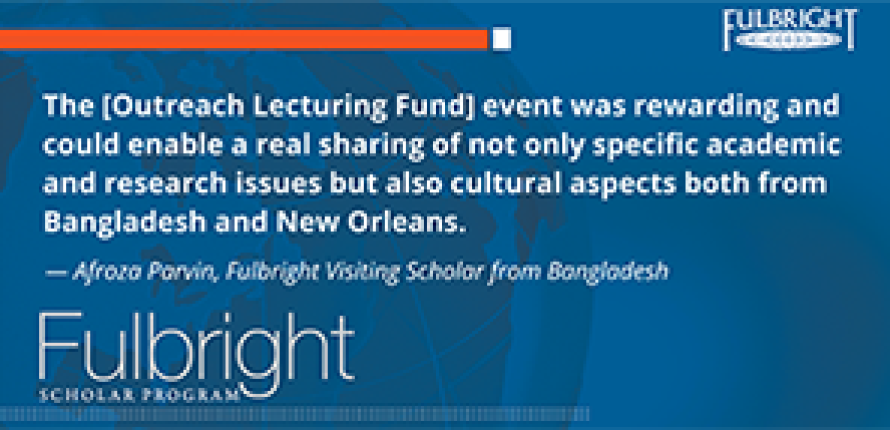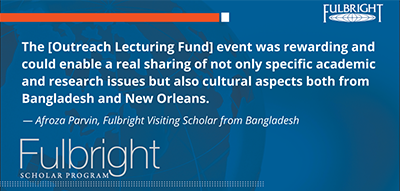Global Lessons Learned from New Orleans: Reflections from Outreach Lecturing Fund Experience

Afroza Parvin, Professor at Architecture Discipline, Khulna University, Bangladesh
2015-2016 Fulbright Visiting Scholar to University of Texas at Austin
Outreach Lecturing Fund participant to Dillard University of New Orleans
As a Fulbright Visiting Scholar, the Fulbright Visiting Scholar Outreach Lecturing Fund (OLF) provided me a great opportunity to share my insights on disaster adaptation practices in Bangladesh and learn from the experience of post-Katrina recovery and city planning process in New Orleans. In collaboration with Dillard University of New Orleans, my trip included a visit to Katrina affected settlements and physical adaptation sites; a formal lecture and dialogue session with the faculty and students of the Urban Studies and Public Policy program and a tour of the historic core of the city.
 During my visit, Professor Collin Robert in the Urban Studies and Public Policy program at Dillard University took me to the Katrina affected settlements and levee sites. From him, I learned about the New Orleans recovery experience, which has a lot to offer in informing other disaster-prone countries about what to do and perhaps more importantly what not to do when planning to rebuild after a disaster. For instance, at the time the recovery planning process began, New Orleans did not have a Master Plan to guide urban planning and recover efforts. While it did have a Comprehensive Zoning Ordinance, the zoning ordinance in place was outdated. The recovery process was thus extremely confusing in part because many different recovery plans emerged simultaneously and most of these plans did not directly relate to each other. In the course of the process of recovery, New Orleans has produced a comprehensive Master Plan for the city. There are three keywords that govern the Master Plan: livability, opportunity, and sustainability. This Master Plan is now guiding the recovery process in an integrated manner. After the site visit, I had a campus tour that acquainted me with the rich academic history and architecture of the university.
During my visit, Professor Collin Robert in the Urban Studies and Public Policy program at Dillard University took me to the Katrina affected settlements and levee sites. From him, I learned about the New Orleans recovery experience, which has a lot to offer in informing other disaster-prone countries about what to do and perhaps more importantly what not to do when planning to rebuild after a disaster. For instance, at the time the recovery planning process began, New Orleans did not have a Master Plan to guide urban planning and recover efforts. While it did have a Comprehensive Zoning Ordinance, the zoning ordinance in place was outdated. The recovery process was thus extremely confusing in part because many different recovery plans emerged simultaneously and most of these plans did not directly relate to each other. In the course of the process of recovery, New Orleans has produced a comprehensive Master Plan for the city. There are three keywords that govern the Master Plan: livability, opportunity, and sustainability. This Master Plan is now guiding the recovery process in an integrated manner. After the site visit, I had a campus tour that acquainted me with the rich academic history and architecture of the university.
At the university, I gave a formal lecture, presenting on my current research work: “Autonomous Adaptation in Built Environment: Towards Resilient Informal Settlements.” The audience was amazing and the lecture turned into an interactive learning session. The students immediately connected to the research problem and led to an enthusiastic Q&A session. Some of the students from similar disaster-prone countries shared the adaptation practices there and made critical comments on that. For example, a student from Trinidad shared how the local people spontaneously adapt to disaster events through simple adjustments (using durable material only in the most damaged parts of the house, raising plinth above flood level using concrete pillars etc.) in their dwelling unit. After the lecture we discussed about potential options to make future academic and research collaboration between Khulna University and Dillard University.
After my lecture, I visited the historic core of the city, the French Quarter, with Dr. Casey. It is the largest and best-preserved district of predominantly 19th century architecture found in an American city. From the beautiful architecture to art galleries, museums, restaurants, and bars, I found the French Quarter has something for everyone – faithfully furnished with domestic goods, decorative arts and art of the period, the 1850s architecture depicts middle class family life during the most prosperous period in New Orleans’s history. Being with Dr. Casey, I could learn and explore more about the fascinating history of the area in general and explore how historic preservation has been used both as a driver for economic development and as a tool for preserving cultural identity and collective memories of city in particular.
Altogether, the OLF event was rewarding and could enable a real sharing of not only specific academic and research issues but also cultural aspects both from Bangladesh and New Orleans. I will cherish this experience throughout my academic career.
